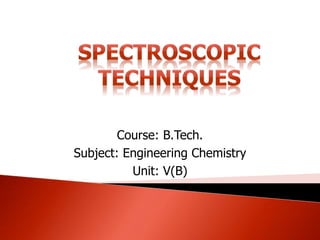
B.tech. ii engineering chemistry unit-5 B spectroscopic techniques
- 1. Course: B.Tech. Subject: Engineering Chemistry Unit: V(B)
- 2. Molecular Spectroscopy: the interaction of electromagnetic radiation (light) with matter (organic compounds). This interaction gives specific structural information. It gives Identification of any compound.
- 3. Optical spectroscopies Techniques for determining the elemental composition of an analyte by its electromagnetic or mass spectrum Mass spectrometries ICP-MS SIMS AASAES Fluoresc- ence Spectros- copy Flame AAS GFAAS ICP-OES UV IR
- 4. General introduction to IR Spectroscopy is the study of the interaction of matter with the electromagnetic spectrum. 1. Electromagnetic radiation displays the properties of both particles and waves 2. The particle component is called a photon. 3. The energy (E) component of a photon is proportional to the frequency. Where h is Planck’s constant and n is the frequency in Hertz (cycles per second) E = hn 4. The term “photon” is implied to mean a small, massless particle that contains a small wave-packet of EM radiation/light – we will use this terminology in the course.
- 5. The entire electromagnetic spectrum Energy (kcal/mol) 300-30 300-30 ~10-4> 300 ~10-6 Frequency, n in Hz ~1015 ~1013 ~1010 ~105~1017~1019 Wavelength, l 10 nm 1000 nm 0.01 cm 100 m~0.01 nm~.0001 nm 1
- 6. Infrared spectroscopy (IR spectroscopy) is the spectroscopy that deals with the infrared region of the electromagnetic spectrum, that is light with a longer wavelength and lower frequency than visible light.
- 7. The infrared portion of the electromagnetic spectrum is usually divided into three regions: near- IR 14000–4000 cm−1 (0.8–2.5 μm) mid- IR 4000–400 cm−1 (2.5–25 μm) far- IR 400–10 cm−1 (25–1000 μm)
- 9. 2
- 10. The infrared spectrum of a sample is recorded by passing a beam of infrared light through the sample. When the frequency of the IR is the same as the vibrational frequency of a bond, absorption occurs. Examination of the transmitted light reveals how much energy was absorbed at each frequency (or wavelength). Alternatively, the whole wavelength range is measured at once using a Fourier transform instrument and then a transmittance or absorbance spectrum is generated using a dedicated procedure. Analysis of the position, shape and intensity of peaks in this spectrum reveals details about the molecular structure of the sample.
- 11. This technique works almost exclusively on samples with covalent bonds. Simple spectra are obtained from samples with few IR active bonds and high levels of purity. More complex molecular structures lead to more absorption bands and more complex spectra. The technique has been used for the characterization of very complex mixtures.
- 12. Infrared spectroscopy is a simple and reliable technique widely used in research and industry. It is used in quality control, dynamic measurement, monitoring applications such as the long-term unattended measurement of CO2 concentrations in greenhouses
- 13. It is also used in forensic analysis in both criminal and civil cases, for example in identifying polymer degradation. It can be used in determining Explosives also.
- 14. Nuclear magnetic resonance (NMR) is a physical phenomenon in which nuclei in a magnetic field absorb and re-emit electromagnetic radiation. This energy is at a specific resonance frequency which depends on the strength of the magnetic field and the magnetic properties of the isotope of the atoms.
- 15. The principle of NMR usually involves two sequential steps: The alignment (polarization) of the magnetic nuclear spins in an applied, constant magnetic field H0. The perturbation of this alignment of the nuclear spins by employing an electro-magnetic, usually radio frequency (RF) pulse. The required perturbing frequency is dependent upon the static magnetic field (H0) and the nuclei of observation.
- 16. Mass spectrometry (MS) is an analytical chemistry technique that helps identify the amount and type of chemicals present in a sample by measuring the mass- to-charge ratio and abundance of gas-phase ions. A mass spectrum (plural spectra) is a plot of the ion signal as a function of the mass-to-charge ratio.
- 17. The spectra are used to determine the elemental or isotopic signature of a sample, the masses of particles and of molecules, and to elucidate the chemical structures of molecules, such as peptides and other chemical compounds. Mass spectrometry works by ionizing chemical compounds to generate charged molecules or molecule fragments and measuring their mass-to-charge ratios.
- 18. In a typical MS procedure, a sample, which may be solid, liquid, or gas, is ionized, for example by bombarding it with electrons. This may cause some of the sample's molecules to break into charged fragments. These ions are then separated according to their mass- to-charge ratio, typically by accelerating them and subjecting them to an electric or magnetic field: ions of the same mass-to-charge ratio.
- 19. The ions are detected by a mechanism capable of detecting charged particles, such as an electron multiplier. Results are displayed as spectra of the relative abundance of detected ions as a function of the mass-to-charge ratio. The atoms or molecules in the sample can be identified by correlating known masses to the identified masses or through a characteristic fragmentation pattern.
- 20. GC-MS LC-MS HPLC-MS GC-MS-MS LC-MS-MS
- 21. Mass spectrometry has both qualitative and quantitative uses. These include identifying unknown compounds, determining the isotopic composition of elements in a molecule, determining the structure of a compound by observing its fragmentation.
- 22. MS is now in very common use in analytical laboratories that study physical, chemical, biological properties of a great variety of compounds.
- 23. 1.www.schome.ac.uk 2.www.shodor.org 3. Principles of instrumental analysis 6th ed by Skoog, Holler, Crouch
- 24. Thank you…………
